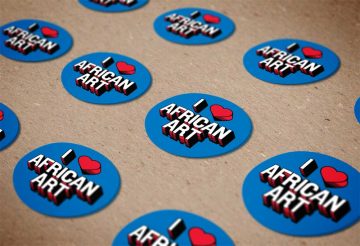 Water is in all of us—we need water to exist. Water is a source of food, either directly from fishing and hunting or indirectly from irrigated crops. Its currents flow through myths, metaphors, and rituals. Water’s fluidity means there are as many meanings associated with it as there are forms. Diverse and wide-ranging in material, time period, style, and intended use, the objects in this exhibition span the continent of Africa to explore the importance of water for both practical and artistic purposes.
Water is in all of us—we need water to exist. Water is a source of food, either directly from fishing and hunting or indirectly from irrigated crops. Its currents flow through myths, metaphors, and rituals. Water’s fluidity means there are as many meanings associated with it as there are forms. Diverse and wide-ranging in material, time period, style, and intended use, the objects in this exhibition span the continent of Africa to explore the importance of water for both practical and artistic purposes.
Oceans separate continents, but their currents also connect them. Waterways deliver new ideas and luxuries. These transportation routes bring both friends and enemies.
Below the surface, water also holds powerful meaning. Water from tears can relate to the profound relationship between a mother and child or connect the spirit world with that of the living. In many parts of Africa, water makes up one part of a philosophical triad along with the sky and the earth, with water the most changeable and most traversable realm. This shifting intersection explains the influence of gods and the ancestors in daily life.
Water features frequently in origin stories. The Dogon of Mali recount tales of aqueous primordial ancestors and of a dog discovering a hidden water source during migration to a new home. The Yoruba along the Oshun River speak of a king’s daughter who was transformed into the river. Other water spirits take form as humans, animals, or a combination of both. These spirits can be protective, yet can also be dangerous if not approached properly.
The iconography of water lends itself to fluid cultural adaptation, like the foreign snake charmer whose likeness was adopted for Mami Wata, the mother of waters. Aquatic creatures worked particularly well as subjects for Akan weights representing subjective proverbs. Water imagery is also tied closely to rulers, such as in the Benin Kingdom, where the use of coral-bead regalia links back to control of oceanic foreign trade.
In their creativity, diversity, and beauty, these artworks from the museum’s permanent collection prove that water is one of most potent forces on earth.
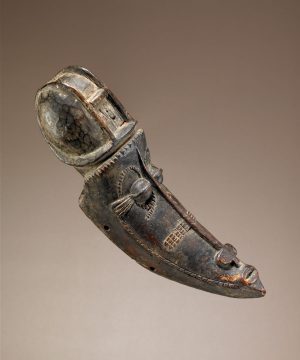
Mask
Early 19th to mid-20th century
Wood
31 x 8.8 x 9 cm (12 3/16 x 3 7/16 x 3 9/16 in.)
Gift of Walt Disney World Co., a subsidiary of The Walt Disney Company, 2005-6-86
The lives and culture of the Ijo revolve around the many waterways of the Lower Niger Delta region and there is a widespread belief in water spirits. They are invoked in festivals, shrines, and masquerades. According to one myth, the masks originated when a woman who had been kidnapped by water spirits returned to her people and told them of the performances she had seen beneath the water.
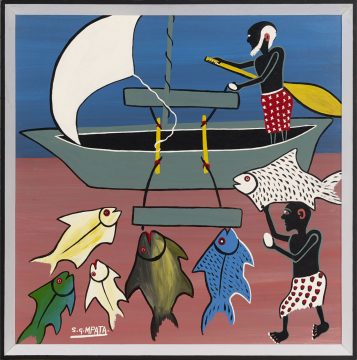
1942–1984, Tanzania
Untitled
1971–73
Enamel paint on fiberboard
61.6 x 61.6 cm (24 1/4 x 24 1/4 in.)
Gift of Ambassador and Mrs. W. Beverly Carter, Jr., 79 28 55
Simon George Mpata’s style of painting is often referred to as Tinga Tinga, a reference to his half brother Edward Tingatinga who organized a group of self-taught artists in Dar es Salaam. Distinguished by bright colors on fiberboard, the majority of the group’s paintings focus on animals in curvilinear decorative patterns. Here, Mpata depicts a scene of fishermen with their catch on Africa’s east coast.

Mask
Mid-20th century
Wood, paint
54 x 28.6 x 17 cm (21 1/4 x 11 1/4 x 6 11/16 in.)
Bequest of Eliot Elisofon, 73-7-167
Mami Wata is recognized by diverse peoples throughout Africa as a powerful water spirit. Her origins can be traced to a late 19th-century German lithograph of a female snake charmer. In the 1950s this image, reprinted in the calendar of an Indian company, was circulated widely in western and central Africa. Interested Africans scrutinized the snake charmer’s image and invested it with a new identity: Mami Wata (Mother Water). They linked her great beauty and foreignness to powers that could provide protection and wealth in an increasingly precarious world.The face mask from Côte d’Ivoire is copied almost directly from the imported image.
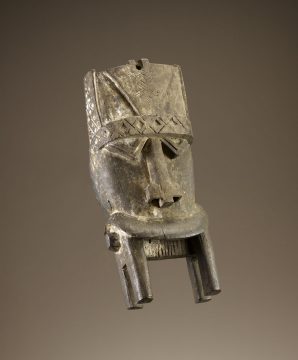
Mask (otobo)
Early 20th century
Wood, pigment
37.8 x 17.3 x 13 cm (14 7/8 x 6 13/16 x 5 1/8 in.)
Museum purchase, 2006-2-1
This mask is in the form of a stylized hippopotamus, a Kalabari Ijo water spirit called otobo. Designed to be worn at a slight angle on top of the head, the mask is a composite creature that combines human features with the hippo’s cylindrical teeth.
Among the Kalabari Ijo, water spirit masks are made from tough mangrove wood because it comes from the creeks where the spirits live.
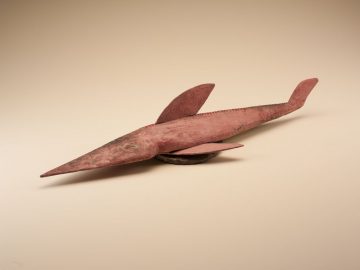
Mask
Mid-20th century
Wood, paint, nails
14.6 x 26 x 81.6 cm (5 3/4 x 10 1/4 x 32 1/8 in.)
Museum purchase, 79-13-11
Masquerades celebrating water spirits are popular in Nigeria’s Niger Delta region. Though playful, mischievous, and linked with the wilderness, Niger Delta water spirits are generally considered more benevolent, kind, and beautiful than other denizens of the wild that inhabit dry land. Water spirit masks take a variety of human and animal forms.This pink fish can be identified as a guitarfish, a type of ray, because of the gills, the mouth on the underside of the body, and the shape of its fins.

Weight
18th to late 19th century
Copper alloy
4.8 x 6.1 x 0.7 cm (1 7/8 x 2 3/8 x 1/4 in.)
Gift of Emil Arnold, 68-36-93
Although often identified with Akan peoples living in south-central Ghana, weights for measuring gold dust were used and traded throughout all of present-day Ghana and Côte d’Ivoire. For more than five centuries, smiths cast weights from wax models or directly from the actual creatures. The resulting objects are immensely diverse in form while set to exact measurement standards.Some weights’ forms were selected just for their beauty or to display the owner’s status. Many, however, evoke Akan proverbs, whose meanings vary with time and place—more than one interpretation can apply. Hence water creatures were popular weights, with their associations of fluidity, flexibility, and movement between worlds.
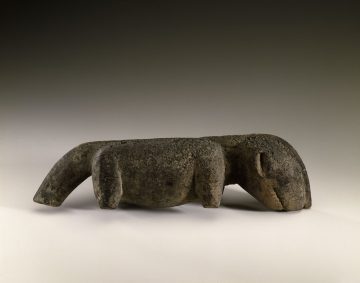
Figure of a dog
Early to mid-20th century
Wood, encrustation
9.7 x 8.3 x 34.5 cm (3 13/16 x 3 1/4 x 13 9/16 in.)
Bequest of Alexandra I. Darrow, 93-9-1
This type of Dogon figure likely depicts a dog. According to oral history, when the Dogon arrived at the sandstone Bandiagara cliffs, they encountered the Tellem peoples who concealed the location of the wells and water holes. A dog returning to camp with wet paws saved the Dogon, allowing them to survive.
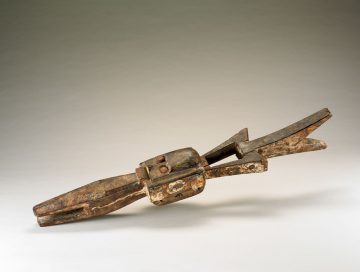
Mask
Mid-20th century
Wood, pigment, iron, plant fiber
101.6 x 17.1 x 12.7 cm (40 x 6 3/4 x 5 in.)
Gift of Walt Disney World Co., a subsidiary of The Walt Disney Company, 2005-6-137
This water spirit mask combines a skull-like human head with a crocodile’s snout and a fish’s tail. When performed at annual festivals, it is worn horizontally on top of the dancer’s head, its imagery facing the sky alluding to the spirits’ view from their underwater abode. Water spirits are associated with positive aspects of change, new objects, new wealth, and new ideas.

Mami Wata figure
Late 20th century
Wood, paint, raffia
67.5 x 53 x 28 cm (26 9/16 x 20 7/8 x 11 in.)
Gift of Flora Edouwaye S. Kaplan, 2009-16-1
In southeast Nigeria among the Anang, figures and masks of Mami Wata blended with ideas of earlier water spirits and deities. She was considered a giver of wealth and also linked with curing infertility. Her brightly painted representations often include long fiber tresses.

Pendant (uhunmwun ekhue)
Late 18th to mid-19th century
Copper alloy, iron
21.6 x 14 x 7 cm (8 1/2 x 5 1/2 x 2 3/4 in.)
Gift of Joseph H. Hirshhorn to the Smithsonian Institution in 1966, 85-19-5
Edo chiefs wear a copper-alloy pendant on their left hips when dressed in full court regalia. This tradition is documented in the dress of figures on palace plaques from the 16th century.This pendant depicts an Edo man, identified by the three raised scars over each eye. He is a person of rank, as shown by his cap of coral beads. The collar of mythical mudfish, emblems of transformation and survival, associates the wearer with spiritual power.
